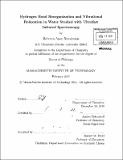Hydrogen bond reorganization and vibrational relaxation in water studied with ultrafast infrared spectroscopy
Author(s)
Nicodemus, Rebecca Anne
DownloadFull printable version (32.25Mb)
Other Contributors
Massachusetts Institute of Technology. Dept. of Chemistry.
Advisor
Andrei Tokmakoff.
Terms of use
Metadata
Show full item recordAbstract
Water consists of an extended hydrogen bond network that is constantly evolving. More than just a description of the time averaged structure is necessary to understand any process that occurs in water. In this thesis we study the dynamic regime, which involves fluctuations and rearrangements that occur on the tens of femtoseconds to picosecond time scale. The dynamic regime involves hydrogen bond breaking and forming which interlaces with translations and reorientation and ultimately largescale reorganization. Our experimental technique is ultrafast infrared spectroscopy of the OX stretch (where X = H, D, or T) of isotopically dilute water. The OX stretch frequency is sensitive to its environment, and loss of frequency correlation provides a picture of local and collective hydrogen bond dynamics. With pump-probe experiments we are also able to measure vibrational relaxation and reorientational dynamics of water. We present the first infrared linear absorption spectrum of the OT stretch of isotopically dilute tritiated water and compare line shape parameters to the other water isotopologues to provide further evidence that electric field fluctuations properly describe line broadening of the infrared spectrum of water. Measurement of the infrared spectrum of tritiated water is the first step towards an experiment that may be capable of directly monitoring the relative geometry between two water molecules during a hydrogen bond switch. We calculate the change in electric field and transition dipole coupling during an idealized hydrogen switch to determine the correlated frequency shifts one might observe in such an experiment. To test the proposed vibrational relaxation pathway in isotopically dilute water, we present the first pump-probe of tritiated water and the temperature-dependent lifetime of deuterated water (or HOD in H20). For the OT and OH stretch, our experimental findings agree with the proposed mechanism in which the vibrational energy first relaxes to the intramolecular bend. However, evidence from the temperature-dependent measurements of the OD stretch show multiple pathways may be in competition that have different dependencies on temperature. Our results call for further experimental and theoretical studies. We acquire temperature-dependent 2D IR and pump-probe anisotropy measurements of the OD stretch of HOD in H20 in order to test if spectral diffusion, which reports on hydrogen bond rearrangements, and reorientation are correlated in water. We compare the temperature dependence of the picosecond decay to a number of measures of structural relaxation and find similar activation barrier heights and slightly non-Arrhenius behavior, which suggests that the reaction coordinate for hydrogen bond reorganization in water is collective.
Description
Thesis (Ph. D.)--Massachusetts Institute of Technology, Dept. of Chemistry, 2011. Cataloged from PDF version of thesis. Includes bibliographical references (p. 189-204).
Date issued
2011Department
Massachusetts Institute of Technology. Department of ChemistryPublisher
Massachusetts Institute of Technology
Keywords
Chemistry.